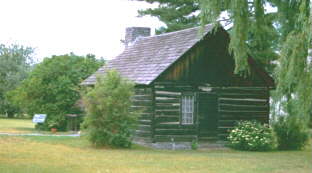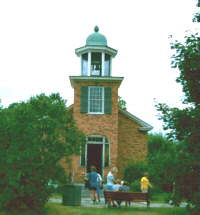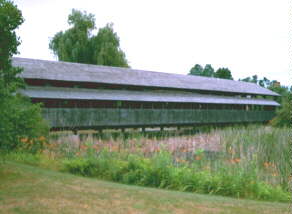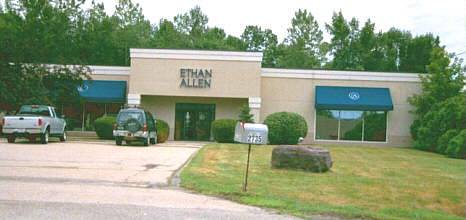SHELBURNEVERMONT |
 |
SHELBURNEVERMONT |
 |
 |
Shelburne Museum's Sawyer's Cabin from East Charlotte, Vermont |
 Shelburne Museum — The museum is a collection of
architectures, artifacts and art from America’s past. Many items in the
collection date back to the Revolutionary War period.
Shelburne Museum — The museum is a collection of
architectures, artifacts and art from America’s past. Many items in the
collection date back to the Revolutionary War period.
One of the oldest homes is the Preston House. It was built in 1773 in Hadley, Massachusetts and moved to its present site in 1955.
Another old home is the Dutton House. It was built in Cavendish, Vermont in 1782. Both houses are of the old “saltbox” style that was commonly found in colonial New England.
The museum's Stagecoach Inn was once on the old colonial route paralleling today’s US Route 7 in Charlotte (pronounced Sha-Lot by Vermonters) in 1783. Charlotte is just south of Shelburne near Lake Champlain. Although the Revolutionary War did not officially end until November of 1783, hostilities began to subside after America’s victory at Yorktown in October 1781. With the construction of inns like the Stagecoach Inn, life in northern Vermont was returning back to normal.
One of the museum's most popular exhibits is the steamship Ticonderoga, America's last vertical beam, side-wheel, passenger steamboat from 1906. The ship is grounded at the museum and in pristine condition.

Village Center — Just north of the museum is the village center. Today, the village is a peaceful, picturesque Vermont town.
During the Revolutionary War, Shelburne was inhabited, but not so peaceful. On March 12, 1778, the village was attacked by a small British force led by a Tory named Philo. Philo was a Shelburne resident and led this attack against his own neighbors. The force included Tories and Indians. Fortunately for the neighbors, they had noticed that the British sympathizers were leaving the area, which tipped-off the impending attack and gave them time to prepare. They fortified the home of Moses Pierson and obtained support from the Vermont Militia stationed in Clarendon (Clarendon is south of Rutland just off US Route 7). The attack on Shelburne was repulsed and the British force retreated back to Canada.
 Ethan Allen Homestead.
As you creep up US Route 7, watch on the right for what is not the Ethan
Allen Homestead. However, this is an example of the home that most people think
of when you mention Ethan Allen. Furniture has, unfortunately for history, made
Ethan Allen better known than the historical person for whom it was named. One
wishes the company would add a little historical corner to their ads in
recognition of their real roots.
Ethan Allen Homestead.
As you creep up US Route 7, watch on the right for what is not the Ethan
Allen Homestead. However, this is an example of the home that most people think
of when you mention Ethan Allen. Furniture has, unfortunately for history, made
Ethan Allen better known than the historical person for whom it was named. One
wishes the company would add a little historical corner to their ads in
recognition of their real roots.
